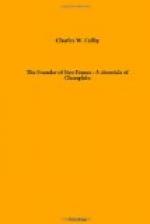Thus when a boy Champlain doubtless had lessons in navigation, but he did not become a sailor in the larger sense until he had first been a soldier. His youth fell in the midst of the Catholic Revival, when the Church of Rome, having for fifty years been sore beset by Lutherans and Calvinists, began to display a reserve strength which enabled her to reclaim from them a large part of the ground she had lost. But this result was not gained without the bitterest and most envenomed struggle. If doctrinal divergence had quickened human hatreds before the Council of Trent, it drove them to fury during the thirty years that followed. At the time of the Massacre of St Bartholomew Champlain was five years old. He was seventeen when William the Silent was assassinated; twenty when Mary Stuart was executed at Fotheringay; twenty-one when the Spanish Armada sailed against England and when the Guises were murdered at Blois by order of Henry iii; twenty-two when Henry iii himself fell under the dagger of Jacques Clement. The bare enumeration of these events shows that Champlain was nurtured in an age of blood and iron rather than amid those humanitarian sentiments which prevail in an age of religious toleration.
Finding his country a camp, or rather two camps, he became a soldier, and fought for ten years in the wretched strife to which both Leaguers and Huguenots so often sacrificed their love of country. With Henry of Valois, Henry of Navarre, and Henry of Guise as personal foes and political rivals, it was hard to know where the right line of faith and loyalty lay; but Champlain was both a Catholic and a king’s man, for whom all things issued well when Henry of Navarre ceased to be a heretic, giving France peace and a throne. It is unfortunate that the details of these adventurous years in Champlain’s early manhood should be lost. Unassisted by wealth or rank, he served so well as to win recognition from the king himself, but beyond the names of his commanders (D’Aumont, St Luc, and Brissac) there is little to show the nature of his exploits. [Footnote: He served chiefly in Brittany against the Spanish allies of the League, and reached the rank of quartermaster.] In any case, these ten years of campaigning were a good school for one who afterwards was to look death in the face a thousand times amidst the icebergs of the North Atlantic, and off the rocky coast of Acadia, and in the forests of the Iroquois.
With such parentage and early experiences as have been indicated Champlain entered upon his career in the New World. It is characteristic that he did not leave the army until his services were no longer needed. At the age of thirty-one he was fortunate enough to be freed from fighting against his own countrymen. In 1598 was signed the Peace of Vervins by which the enemies of Henry iv, both Leaguers and Spaniards, acknowledged their defeat. To France the close of fratricidal strife came as a happy release. To Champlain it meant also the dawn of a career. Hastening to the coast, he began the long series of voyages which was to occupy the remainder of his life. Indeed, the sea and what lay beyond it were henceforth to be his life.




